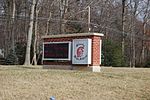Ellerslie (Glenwood, Maryland)
Located Glenwood in Howard County, Maryland, United States, Ellerslie Plantation. The Elerslie slave plantation was built on the lands of Captain Thomas Hobbs given to his daughter Amelia. Jasper and Amelia Peddicord built a house (later side-by-side) around a log hunting lodge built about 1763. These were built on portion of land patented as "Ridgley's Great Range. In 1830, Richard Snowden purchased the land for a wedding present. In 1835, Nicholas Snowden of Montpeiler married Elizabeth Ridgley Warfield. Richard and his sons left to pursue the California Gold Rush. The House was purchased in 1845 by Basil Crapster who expanded the house to an unusual mirrored layout with a duplicate addition on the Western Portion. In 1945 Jaessie Hakes and his wife purchased the manor and 132 acres of surrounding land plus adjoining properties which have been subdivided for residential construction. The manor is a two and one-half story house with stone construction. Outbuildings include a stone spring house and wood barn built in the late 1700s.
Excerpt from the Wikipedia article Ellerslie (Glenwood, Maryland) (License: CC BY-SA 3.0, Authors).Ellerslie (Glenwood, Maryland)
Glenwood Springs Drive,
Geographical coordinates (GPS) Address Nearby Places Show on map
Geographical coordinates (GPS)
| Latitude | Longitude |
|---|---|
| N 39.294166666667 ° | E -77.021666666667 ° |
Address
Glenwood Springs Drive
Glenwood Springs Drive
21738
Maryland, United States
Open on Google Maps



